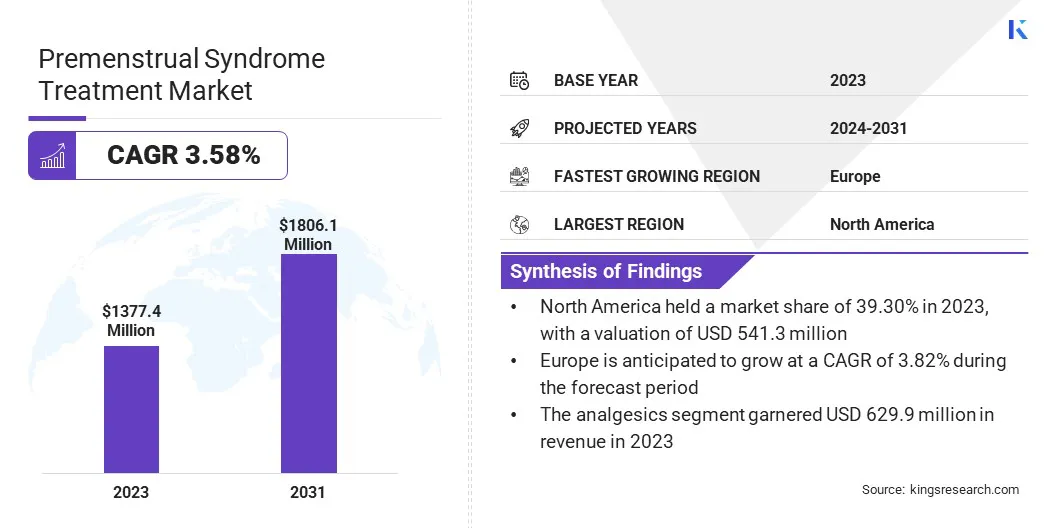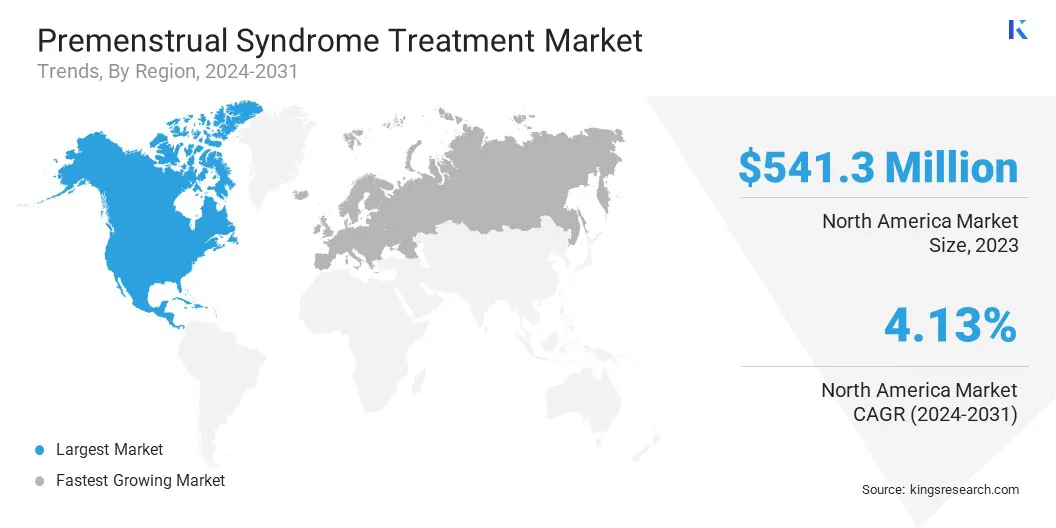Premenstrual Syndrome Treatment Market Size
The global Premenstrual Syndrome Treatment Market size was valued at USD 1,377.4 million in 2023 and is projected to grow from USD 1,411.6 million in 2024 to USD 1,806.1 million by 2031, exhibiting a CAGR of 3.58% during the forecast period. The market is experiencing substantial growth, mainly driven by the widespread prevalence of PMS and its more severe variant, premenstrual dysphoric disorder (PMDD). Significant socio-economic impacts, such as job loss underscore the need for effective treatments.
Advances in personalized medicine, tailored to genetic, hormonal, and lifestyle factors, are addressing these needs, thereby propelling market expansion and improving the quality of life for affected individuals. In the scope of work, the report includes solutions offered by companies such as Bayer AG, GlaxoSmithKline, H. Lundbeck A/S, Pfizer Inc, Asarina Pharma AB, Mylan N.V., Teva Pharmaceutical Industries Ltd., Pherin Pharmaceuticals, Novartis International AG, Umecrine Mood AB, and others.
The profound socio-economic impacts of premenstrual dysphoric disorder (PMDD) are emerging as a key factor fueling the growth of the premenstrual syndrome treatment market.
- According to the International Association for Premenstrual Disorders (IAPMD), PMDD is associated with job loss in 16.8% of cases and dissolution of intimate partner relationships in 56.7% of cases. Additionally, it places substantial strains on intimate partner relationships (98%) and family dynamics (97%), with parenting challenges reported by 42.7% of individuals.
These statistics highlight a strong demand for effective treatments capable of reducing these socio-economic burdens. Addressing these multifaceted impacts through advanced, personalized therapies tailored to genetic, hormonal, and lifestyle factors is crucial for meeting the market's evolving needs and enhancing quality of life for those affected by PMDD.
Premenstrual syndrome (PMS) treatment involves various approaches to mitigate the physical, emotional, and behavioral symptoms that occur during the latter half of the menstrual cycle. Pharmacological options include NSAIDs for pain relief, hormonal treatments such as oral contraceptives, and antidepressants such as SSRIs.
Lifestyle modifications, including dietary changes, regular exercise, and stress management, help reduce symptoms. Supplements such as calcium, magnesium, and vitamin B6 are further commonly recommended for the treatment of PMS. Some women use complementary therapies such as acupuncture, yoga, and herbal remedies. The primary goal of PMS treatment is to lessen symptom severity, enhance quality of life, and reduce daily disruptions.

Analyst’s Review
The rising use of antidepressants is propelling the growth of the premenstrual syndrome (PMS) treatment sector, mainly due to their effectiveness in managing mood-related symptoms of PMS and premenstrual dysphoric disorder (PMDD). Selective serotonin reuptake inhibitors (SSRIs) and other antidepressants offer significant relief from depression, anxiety, and irritability, thus improving the quality of life for affected individuals.
According to our analysis, antidepressants segment is expected to grow at a CAGR of 4.27% over the forecast period. Ongoing research and development efforts are enhancing their effectiveness and safety profiles, thereby boosting adoption and stimulating market growth.
Key players are expanding their portfolios by developing innovative antidepressant formulations, investing in R&D, and collaborating with healthcare providers to increase awareness and improve diagnosis rates, thereby meeting the growing demand for PMS and PMDD treatments.
Premenstrual Syndrome Treatment Market Growth Factors
The high prevalence of premenstrual syndrome (PMS), characterized by recurring physical and behavioral symptoms during the second half of the menstrual cycle, is a major factor aiding market growth. PMS affects a substantial number of women globally, creating a strong demand for effective treatment solutions.
Additionally, premenstrual dysphoric disorder (PMDD), the most severe form of PMS, impacts approximately one in 20 women or AFAB (assigned female at birth) individuals of reproductive age. PMDD is marked by severe emotional and physical symptoms that can significantly disrupt daily life, thereby necessitating specialized treatment.
- According to the International Association for Premenstrual Disorders (IAPMD), 34% of individuals with PMDD have attempted suicide during an episode, highlighting the critical need for effective interventions. Patients, on average, endure a 12-year period and consult 6.15 providers before receiving an accurate diagnosis.
This delay in diagnosis and the severe impact on quality of life emphasize the urgent need for improved diagnostic and therapeutic solutions, thus fostering the growth of the market.
Premenstrual Syndrome Treatment Industry Trends
The development of new and effective treatments for premenstrual syndrome (PMS) is augmenting market growth by addressing the need for better symptom management. Hormonal therapies and SSRIs provide significant relief, thereby broadening treatment options. Additionally, non-pharmacological interventions such as CBT, acupuncture, and lifestyle changes are gaining immense popularity.
Innovations in drug formulations and delivery methods, such as transdermal patches and long-acting injectables, improve accessibility and promote patient adherence. These advancements attract more women to seek treatment, thereby supporting market expansion. The increased efficacy, variety, and convenience of treatments are further contributing to the growth of the market.
The growing trend toward personalized medicine in the premenstrual syndrome (PMS) treatment market focuses on tailoring treatments based on individual patient profiles, which include genetic, hormonal, and lifestyle factors. This approach aims to improve efficacy and reduce side effects by addressing specific needs.
For instance, genetic testing identify hormonal imbalances, allowing for the implementation of targeted therapies, while lifestyle assessments guide non-pharmacological interventions such as diet and exercise. Personalized medicine enhances treatment effectiveness and patient satisfaction, as regimens are customized to individual requirements. This significant trend offers the potential for better outcomes and improved quality of life for those affected by PMS.
Segmentation Analysis
The global market is segmented based on drug type, type, distribution channel, and geography.
By Drug Type
Based on drug type, the market is categorized into analgesics, antidepressants, oral contraceptives & ovarian suppression agents, and others. The analgesics segment led the premenstrual syndrome treatment market in 2023, reaching a valuation of USD 629.9 million. Analgesics, including nonsteroidal anti-inflammatory drugs (NSAIDs) and acetaminophen, effectively alleviate symptoms such as cramps, headaches, and muscle aches.
Growing awareness of PMS and the rising preference for over-the-counter pain relievers are boosting the demand for these medications due to their convenience and accessibility. Continuous innovation in analgesic formulations improves both efficacy and safety, leading to their widespread adoption. As more women seek relief and healthcare providers recommend analgesics as primary treatments, the segment is witnessing substantial expansion.
By Type
Based on type, the market is divided into prescription, OTC. The prescription segment captured the largest premenstrual syndrome treatment market share of 71.34% in 2023. Prescription medications, including hormonal treatments and antidepressants such as SSRIs, provide significant relief from emotional and physical symptoms, thereby improving the quality of life for affected individuals.
As awareness of PMS and PMDD rises, a growing number of women are seeking medical advice, resulting in higher demand for these therapies. Healthcare providers often recommend prescriptions when over-the-counter options are insufficient. Ongoing research and development are also leading to new formulations that enhance treatment efficacy and improve patient adherence, thereby propelling the growth of the segment.
By Distribution Channel
Based on distribution channel, the market is categorized into hospital pharmacies, drug stores & retail pharmacies, and online pharmacies. The drug stores & retail pharmacies segment is expected to garner the highest revenue of USD 833.0 million by 2031. These outlets offer over-the-counter medications, including analgesics, hormonal treatments, and dietary supplements, making it convenient for consumers to find effective solutions.
Increased consumer preference for local pharmacies for immediate relief and personalized advice further boosts demand. Additionally, promotional activities and educational campaigns contribute to increasing awareness regarding PMS treatments, while the growth of e-commerce enhances accessibility, significantly propelling segmental growth.
Premenstrual Syndrome Treatment Market Regional Analysis
Based on region, the global market is classified into North America, Europe, Asia-Pacific, MEA, and Latin America.

North America premenstrual syndrome treatment market share stood around 39.30% in 2023 in the global market, with a valuation of USD 541.3 million. This growth is largely attributed to a high prevalence of PMS and PMDD. The regional market benefits from advanced healthcare infrastructure and a strong emphasis on women's health initiatives, leading to increased awareness and improved diagnosis rates. The availability of both prescription and over-the-counter treatments is contributing to the rising demand.
Additionally, significant investment in research and development fosters innovative therapies, while major pharmaceutical companies and retail chains ensure widespread distribution. Collaborative efforts between healthcare providers and pharmacies further enhance patient education and treatment adoption, positioning North America as a key region in the PMS treatment market.
Europe is anticipated to witness significant growth at a CAGR of 3.82% over the forecast period. The emphasis on personalized medicine is growing, with increasing demand for tailored therapies specifically tailored to individual patient profiles. Additionally, the region is witnessing a rise in telemedicine and digital health solutions, which facilitate easier access to healthcare professionals and treatment options.
Economic factors, such as rising disposable incomes and health insurance coverage, further augment regional market growth. Furthermore, European regulatory bodies are increasingly supporting innovative treatment approaches, promoting the development and approval of new PMS therapies, and thus supporting regional market development.
Competitive Landscape
The global premenstrual syndrome treatment market report will provide valuable insight with an emphasis on the fragmented nature of the industry. Prominent players are focusing on several key business strategies such as partnerships, mergers and acquisitions, product innovations, and joint ventures to expand their product portfolio and increase their market shares across different regions.
Companies are implementing impactful strategic initiatives, such as expanding services, investing in research and development (R&D), establishing new service delivery centers, and optimizing their service delivery processes, which are likely to create new opportunities for market growth.
List of Key Companies in Premenstrual Syndrome Treatment Market
- Bayer AG
- GlaxoSmithKline
- Lundbeck A/S
- Pfizer Inc
- Asarina Pharma AB
- Mylan N.V.
- Teva Pharmaceutical Industries Ltd.
- Pherin Pharmaceuticals
- Novartis International AG
- Umecrine Mood AB
The global premenstrual syndrome treatment market is segmented as:
By Drug Type
- Analgesics
- Antidepressants
- Oral Contraceptives & Ovarian Suppression Agents
- Others
By Type
By Distribution Channel
- Hospital Pharmacies
- Drug Stores & Retail Pharmacies
- Online Pharmacies
By Region
- North America
- Europe
- France
- U.K.
- Spain
- Germany
- Italy
- Russia
- Rest of Europe
- Asia-Pacific
- China
- Japan
- India
- South Korea
- Rest of Asia-Pacific
- Middle East & Africa
- GCC
- North Africa
- South Africa
- Rest of Middle East & Africa
- Latin America
- Brazil
- Argentina
- Rest of Latin America


